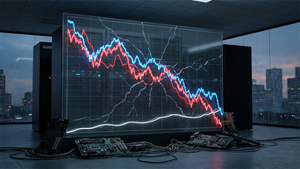
The precious metals market is abuzz with speculation as analysts increasingly suggest that the recent price pullbacks in gold and silver may be the final consolidation before a significant "parabolic" upward trend. As of November 21, 2025, a complex interplay of technical indicators, persistent inflationary pressures, global economic uncertainties, and the structural implications of a K-shaped economy are fueling this bullish outlook, positioning these metals as crucial hedges in an unpredictable financial landscape.
This sentiment has gained traction despite a notable dip in mid-November, with market observers interpreting the current volatility not as a sign of weakness, but rather as a coiled spring. Investors are closely watching for triggers that could ignite the next major rally, anticipating that gold and silver could soon embark on a historic ascent, challenging previous all-time highs and potentially soaring to unprecedented levels.
The Recent Pullback: A Strategic Retreat or a Deeper Dive?
The precious metals market experienced a significant correction in mid-November 2025, following a period of robust gains. Gold prices saw a sharp decline of over 3%, dropping by more than $130 to trade near $4030 per ounce around November 15, after touching an intraday high of $4,250. Silver mirrored this movement with a substantial 4% decrease, approaching $50 per ounce, having earlier surged to an all-time high of $54.42 per troy ounce in October. These pullbacks occurred after both metals reached all-time highs in early to mid-October 2025, with gold peaking at approximately ₹1,30,874 on October 17 and silver at ₹1,78,100 on October 14 in Indian markets.
Several factors converged to trigger this recent depreciation. A primary driver was a more hawkish stance from the U.S. Federal Reserve, with officials signaling caution on interest rate cuts, which bolstered the US dollar and made non-interest-bearing assets less appealing. Stronger-than-expected US jobs data, particularly the September non-farm payrolls exceeding forecasts, further dampened hopes for imminent rate cuts, pushing down the probability of a December cut and strengthening the dollar. Additionally, profit-taking by traders after months of robust gains contributed to the slump. Some reports also cited an easing of geopolitical tensions, such as a mostly holding Israel-Hamas ceasefire and US airstrikes on Iranian nuclear facilities, which can temporarily reduce safe-haven demand for precious metals.
Companies Poised to Win or Lose in a Parabolic Surge
A parabolic rise in gold and silver prices would significantly impact public companies across the mining and investment sectors. Mining companies, particularly those with substantial proven reserves and efficient operations, stand to be major beneficiaries.
Companies like Barrick Gold (NYSE: GOLD) and Newmont Corporation (NYSE: NEM), two of the world's largest gold producers, would see their revenues and profit margins surge dramatically. Higher metal prices directly translate to increased earnings per share, potentially leading to higher stock valuations, increased dividends, and expanded exploration budgets. Similarly, major silver producers such as Pan American Silver Corp. (NASDAQ: PAAS) and First Majestic Silver Corp. (NYSE: AG) would experience a substantial boost. Their extensive silver portfolios would become significantly more valuable, driving strong financial performance. Royalty and streaming companies like Wheaton Precious Metals Corp. (NYSE: WPM) and Franco-Nevada Corporation (NYSE: FNV) are also set to win big, as their business model guarantees a percentage of future production or revenue, which would naturally increase in value with rising metal prices, often with fixed costs, leading to exponential profit growth.
Conversely, companies that have significant short positions in gold or silver, or those with high debt loads that rely on stable or lower commodity prices for operational solvency, could face considerable challenges. While fewer direct "losers" exist in a rising precious metals market, some industrial users of silver might see increased input costs, though this is often offset by the broader economic conditions that drive up precious metal prices. Exchange-Treded Funds (ETFs) that track gold and silver, such as SPDR Gold Shares (NYSE: GLD) and iShares Silver Trust (NYSE: SLV), would see their net asset values climb, benefiting investors holding these instruments.
Wider Significance: A Reflection of Deeper Economic Shifts
This anticipated parabolic rise in gold and silver prices is not an isolated event but rather a symptom and a reflection of broader, more profound shifts in the global economic landscape. It fits squarely into a trend of increasing investor distrust in traditional fiat currencies and a flight towards tangible assets in an era of persistent inflation and economic uncertainty. The ongoing inflationary pressures globally continue to erode purchasing power, making gold and silver, historically revered as hedges against inflation, increasingly attractive.
The emergence of a "K-shaped economy" plays a critical role in this dynamic. A K-shaped recovery signifies a divergence where certain segments of the economy and population thrive, while others struggle. This growing wealth inequality often compels central banks to maintain accommodative monetary policies, even in the face of inflationary risks, leading to negative real interest rates. Such an environment devalues fiat currencies and enhances the appeal of non-yielding assets like precious metals. The inherent instability and uncertainty bred by this K-shaped recovery further amplify the safe-haven demand for gold and silver, as investors seek stability amidst financial stress. Central banks worldwide are also consistently accumulating gold reserves as part of de-dollarization efforts and for strategic diversification, providing a fundamental floor and structural demand for the metal. For silver, robust and growing industrial demand, particularly from green technologies such as solar panels and electric vehicles, coupled with a multi-year physical market deficit projected to continue through 2025, adds another layer of fundamental support.
What Comes Next: Navigating the Precious Metals Boom
In the short term, market participants will be closely watching for a sustained break above key technical resistance levels for both gold and silver. For gold, a decisive move above $4,250, followed by $4,380, could signal the acceleration towards the $5,000 psychological barrier. Silver's trajectory hinges on surpassing its recent high of $54.30-$54.42, which could pave the way for targets at $57 and potentially $63.80. The immediate days and weeks will likely see continued volatility as traders position themselves, but the underlying sentiment suggests that any further dips could be viewed as buying opportunities.
In the long term, the implications of a parabolic rise are significant. It could signal a profound shift in global asset allocation, with a greater emphasis on real assets over financial instruments. This could prompt strategic pivots for institutional investors, rebalancing portfolios to increase exposure to precious metals and related equities. Market opportunities will emerge not only in direct metal investments but also in mining technology, exploration companies, and even in the development of new financial products tied to precious metals. Challenges might include increased regulatory scrutiny on speculative trading and potential market bubbles if the ascent becomes too rapid. Potential scenarios range from a steady, sustained climb driven by fundamental demand to a more volatile, speculative surge fueled by retail FOMO (fear of missing out). Investors should prepare for increased market attention on inflation data, central bank policy shifts, and geopolitical developments, all of which will serve as catalysts or headwinds.
Comprehensive Wrap-up: The Enduring Allure of Gold and Silver
The current market sentiment, suggesting a potential parabolic rise in gold and silver following a recent pullback, underscores a critical juncture in financial markets. The key takeaways are clear: while short-term volatility persists, the confluence of technical indicators, persistent inflation, global economic uncertainty exacerbated by a K-shaped economy, and strong fundamental demand from central banks and industrial sectors (for silver) points towards a robust bullish outlook. The recent dip, far from signaling weakness, appears to be a consolidation phase, providing a potential springboard for future gains.
Moving forward, the market is poised for significant movement. Gold and silver are reasserting their roles as essential safe-haven assets and inflation hedges in an environment characterized by currency debasement and economic disparity. Their performance will likely serve as a barometer for broader economic health and investor confidence in traditional financial systems. Investors should closely monitor macroeconomic data, particularly inflation rates and central bank interest rate decisions, as well as geopolitical developments. The potential for a parabolic surge offers both significant opportunities and risks, demanding a vigilant and informed approach. The enduring allure of gold and silver, rooted in millennia of human history, appears set to shine even brighter in the coming months, solidifying their place as strategic components of a diversified investment portfolio.
This content is intended for informational purposes only and is not financial advice






